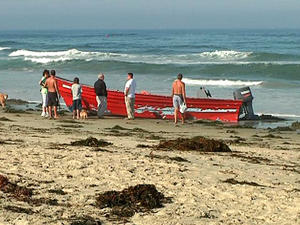Border securityNew illegal immigration frontier: the sea
There is a new frontier for illegal immigrants entering the United States — a roughly 400-square-mile ocean expanse that stretches from a bullring on the shores of Tijuana, Mexico, to suburban Los Angeles; in growing numbers, migrants are gambling their lives at sea as land crossings become even more arduous and likely to end in arrest; while only a small fraction of border arrests are at sea; authorities say heightened enforcement on land, and a bigger fence are making the offshore route more attractive

An abandoned panga, immigrant-smuggling boat // Source: typepad.com
The speedboat is about three miles offshore when a U.S. Customs and Border Protection (CBP) agent cuts the engine to drift on the current in quiet darkness, hoping for the telltale signs of immigrant smuggling — sulfur fumes or a motor’s whirr. “It’s like trying to find a needle in a haystack, and the haystack is the Pacific Ocean,” agent Tim Feige says minutes before sunrise marks the end to another uneventful shift.
This is a new frontier for illegal immigrants entering the United States — a roughly 400-square-mile ocean expanse that stretches from a bullring on the shores of Tijuana, Mexico, to suburban Los Angeles. In growing numbers, migrants are gambling their lives at sea as land crossings become even more arduous and likely to end in arrest.
Sea interdictions and arrests have spiked year-over-year for three years, as enforcement efforts ramp up to meet the challenge.
AP reports that while only a small fraction of border arrests are at sea, authorities say heightened enforcement on land, and a bigger fence, are making the offshore route more attractive. The number of Border Patrol agents doubled to more than 20,000 since 2003, and President Barack Obama is dispatching the National Guard after clamor for a crackdown in the desert led to Arizona’s tough new immigration law.
“Your options are to go east through the mountains and the desert, or west through the ocean, or you tunnel underground,” said Michael Carney, deputy special agent in charge of investigations for U.S. Immigration and Customs Enforcement (ICE) in San Diego. “I think they found that going west through the ocean is probably their best bet.”
U.S. agents have arrested 753 suspected illegal immigrants on Southern California shores and seas between October and 24 August, up from 400 the previous 12 months and 230 the year before. They have spotted 85 watercraft since October, up from 49 during the previous 12 months and 33 the year before.
The smugglers use old, single-engine wooden vessels known in Mexico as pangas. They are several feet wide and about twenty-five feet long. If they are found on U.S. waters, they are almost invariably smuggling people or drugs.
U.S. authorities have stepped up sea patrols near the border, forcing pangas loaded with illegal immigrants and sometimes with marijuana farther offshore with landings farther north.
Authorities believe smugglers put their passengers ashore and return to Mexico, when possible, to avoid losing their boats and leaving evidence behind. They quickly abandon the boats and run for it, though. if they sense they are about to be caught.
AP notes that smuggling on California waters dates back to the alcohol trade during Prohibition, but authorities noticed a change in late 2007 when pangas began traveling without lights at night with up to 25 people packed on open decks. At up to $5,000 a person — roughly twice the fee to cross illegally over land — one overnight trip can generate $100,000.
The low-slung boats, when weighed down with people, can float only about one foot above water, making them difficult to see on radar. Night-vision binoculars have limited reach. “They’re beating us with low-tech,” said ICE’s Carney. “I’m not saying they can’t be detected, but I’m saying they’re very hard to detect.”
